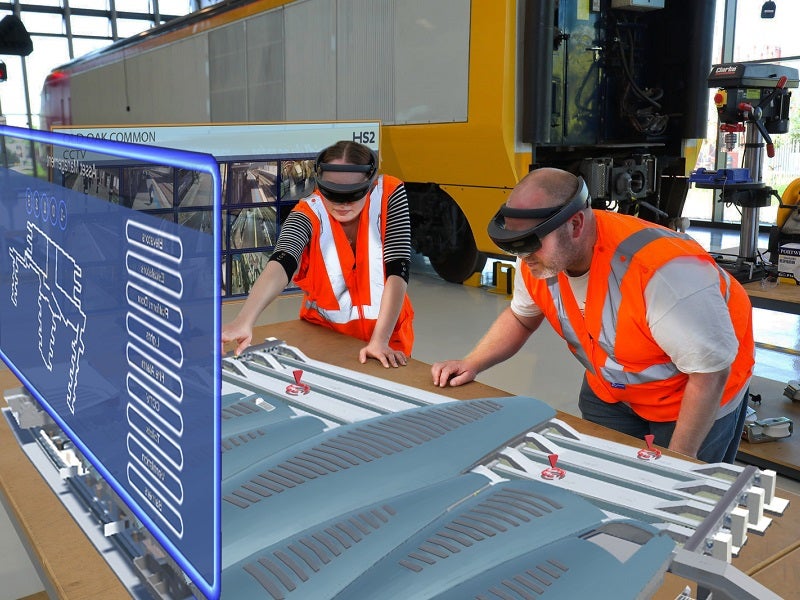
The augmented reality (AR) market has grown exponentially over the past few years, with a recent study published by market research company MarketsandMarkets estimating that it could grow from $10.7bn in 2019 to $72.7bn by 2024.
One of the most popular technologies of the last decade, AR is defined in the Collins Dictionary as “an artificial environment created through the combination of real-world and computer-generated data”. Over the past few years, several sectors have been showing interest in using AR, which is now available in the entertainment realm – both in videogames and figurative arts – as well as the healthcare and army spheres.
The technology is also showing significant potential for rail applications, providing a much-needed three-dimensional approach to segments of the sector that have long been limited, such as maintenance and training.
Staff training

In rail, just like many other sectors, AR is making staff training more dynamic, engaging and efficient. The use of this technology for training purposes has increased over the past few years, as it helps simplify and speed up the process. Most of all, AR shows employees realistic scenarios that teach them how to act on-site.
On a practical level, the technology is now being used by engineers at HS2, the UK’s upcoming high-speed rail line currently under construction. During the summer, the company launched an immersive AR technology that created a replica of its new London hub, the Old Oak Common station.
How well do you really know your competitors?
Access the most comprehensive Company Profiles on the market, powered by GlobalData. Save hours of research. Gain competitive edge.

Thank you!
Your download email will arrive shortly
Not ready to buy yet? Download a free sample
We are confident about the unique quality of our Company Profiles. However, we want you to make the most beneficial decision for your business, so we offer a free sample that you can download by submitting the below form
By GlobalDataAhead of its opening, staff are using this solution to train on customer experience, safety and maintenance of the station, which is set to handle 275,000 commuters per day. Through the technology, trainees can also provide feedback on the development of the station, its design and construction.
All things maintenance
Rail maintenance is often an unsafe, impractical and limited task, as it depends on factors such as weather conditions and the state of infrastructure. Adding to this, the industry has long been searching for ways to better predict problems before they occur, saving times and costs, as well as boosting passenger appreciation.
AR allows tracks to be checked remotely and, if combined with technologies such as advanced weather forecasting and artificial intelligence, it can assist with predictive maintenance.
In 2016, for example, employees working on the Greater Boston commuter rail system wore smart glasses fitted with AR technology that visually connected them to off-site staff. This allowed for continuous communication and real-time vision of works between the two locations, resulting in cost savings and improved maintenance.
Meanwhile, in the UK, engineering start-up Enable My Team is preparing to launch a technology designed to predict train track and signalling equipment failures in advance. Set to launch in 2020, it uses AR through a smartphone or a head-mounted display to trace faults in real-time, alerting engineers that action is required.
Tackling overcrowding
Rail passenger rates are booming all around the world, with traffic peaking near big metropolitan cities. This is giving operators a real headache, as initiatives such as introducing more trains and expanding networks take time and money, so can only tackle overcrowding in the long term. Technology, on the other hand, can have nearly immediate effects.
In October, congestion-plagued Shanghai tested a pair of AR smart glasses to ease passenger flows ahead of the China International Import Expo. Fitted with cameras that live stream commuter traffic directly to a station’s command platform, these can help officers quickly identify bottlenecks. The product is also helping with security checks, as the glasses offer facial recognition and have built-in intelligence voice recognition systems.
On trial in the weeks leading up to the event, the glasses have now been adopted across several subway systems from Shanghai to Luoyang and Gansu.
Customer engagement
Trainline.jpg” alt=”” width=”800″ height=”450″ />
On the customers’ end, AR is all about providing entertainment and information on a specific service or station. Over the past few years, the industry has shown surprising creativity and innovation in this field.
For example, the Swiss Federal Railways recently launched an AR preview app at Zurich’s main station that improves wayfinding in crowded areas. By pointing their phone towards an information board or a specific location, travellers can find details about a particular service, shops around the station, and the location of bus and tram stops nearby.
Earlier in 2019, British digital rail platform Trainline used AR to promote train transport against other more polluting alternatives. In this spirit, the company rolled out a series of posters near London Waterloo which, when scanned through a QR code, showed personalised train times and the carbon footprint passengers would save by ditching their cars in favour of rail.
Another creative initiative is Kansas City’s Union Station’s Living History app, which was launched in 2014 to celebrate the station’s centenary. A digital exhibit of the station’s most iconic moments, the app takes passengers through a virtual historical tour of the building.
Previewing designs and overseeing construction
British infrastructure manager Network Rail pioneered this application in October last year, when it launched an app that allowed passengers to visualise replacement footbridges at stations. Called ARki, the app was designed to allow local communities to preview future infrastructure ahead of Network Rail’s launch of a new generation of footbridges.
Earlier in the year, overnight sleeper train services adopted a similar initiative before the rollout of its new fleet of trains. Those interested in inspecting the design and furniture of the new carriages could use the company’s AR app to have a 3D interactive preview.







